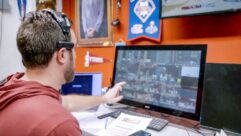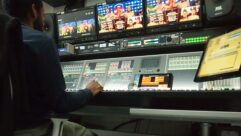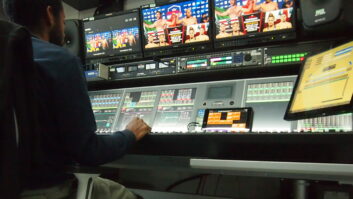
At Ohio’s Kettering College, medical sonography students had a sophisticated classroom lab, but problems with its operation were causing a lot of IT assistance calls. The college decided to revamp the lab; Mark Crumbacher of Custom Connections is here with the story.
SVC: We have a fairly ambitious project to talk about here but before we dive in, tell us about Custom Connections.
Mark Crumbacher: We’ve been around since 2003 and we pretty much do anything audio/video. We started off as a residential company and then quickly got into the commercial and now we do just as much commercial as residential. We’ve got hundreds and hundreds of customers locally. We work anywhere. I think we’ve gone as far south as South Carolina and as far north as New York. One of our specialties is surveillance. We do an enormous amount of surveillance not only for our residential customers, but we do a lot of businesses.
Kettering College had a pretty sophisticated medical sonography lab. We know there were frequent problems but when the system did work right, what were its capabilities?
You know, we were actually kind of surprised because the equipment they had in the room actually could have provided much more flexibility than it was programmed for. They used a composite video matrix that allowed them to just do one-to-one, two-to-two, three-to-three, then multiple displays throughout these individual little rooms or labs. Bed 1 went to Display 1, and Bed 2 went to Display 2, and so on. It was limited. They wanted it to do much more, but actually the main reason for the upgrade was the unreliability–the system seemed to always break down. It seemed to always need some kinid of update, or there was an issue with the GUI–the control pad at the professors’ desk. Students were having some difficult times. For example, if they wanted to see what was going on at Bed 5 that wasn’t easy. There are seven different beds and multiple students at each bed, so to tell the entire class to go over to Bed 5 just made it difficult. So there were lots of limitations. And then when they had problems, their biggest complaint was “My Lord, we have to contact the company who installed it. We have to set up the appointment. We have to pay a fee to have them get into the programming and reprogram.” They seemed to be doing this more often than not. They just kind of got fed up.
I can imagine. And it would not only be frustrating for the students but it would make it very difficult for the professors to keep up with their lesson plans.
Yeah.
Now, who kept this thing up and running? Was that totally overseen by the department’s own tech people or was it the college IT?
It was a little bit of both. I mean obviously when you’re in the middle of a class with 50 students and they’re having a technical difficulty, they try to push every button they know to make it work. But eventually it defaulted to the college’s IT department. We had a good relationship with them around other classrooms. So they finally reached out and asked for help to figure this out.
And a lot of times the IT people are not well versed in AV and vice versa.
Yeah. Oh, I agree completely. It’s weird, you would imagine we’re all kind of in the same industry or we’re under the same umbrella. But it’s really two totally different types of markets and yeah, they reached out to us because they had no clue.
 How did Custom Connections assess the system and determine exactly what the solution would be?
How did Custom Connections assess the system and determine exactly what the solution would be?
The most important thing was just listening. Some AV companies go into situations and they’ve got a solution in their back pocket that will work great or they make high margins on. We took a step back; we needed to really listen to what they want. Obviously it’s not going to be cheap. So if they’re going to be spending good money, we need to make sure the solution we provide them is exactly what they’re looking for. And that process also means we can go back and say “remember when we talked about this? This is the solution. You’re getting exactly what you’re asking for.”
In this situation, we first had a face-to-face conversation with IT on how everything is supposed to work, how they want it to work, the issues the professors and students have had, the help tickets that have been put in, and the issues they’ve been having. And then IT brought in the professors themselves, which is wonderful because sometimes these companies try to take everything on themselves and don’t go to the source. They don’t go to the person actually having the problem. So we all sat down to work this out and listened and conversed. “What do you need? What’s not working? What do you need to work? How do you want it to work?” And then we also had to look into the future of this classroom? Are you guys going to be changing things? Are you going to be moving things around?”
How much of the existing tech gear did you leave in place and how much was newly installed?
We pretty much took the electronics out all together. The only thing left in place was some fiber CAT-6 throughout the walls. All of that wiring we were able to reuse, which was fantastic. So we ended up replacing all of their monitors at each bed location of the sonography lab. We also installed a monitor suspended from the ceiling so that the students see their machine locally, but they can also look up and see it on a big monitor. All the monitors they had were old, very old. Really low resolution, really low brightness, contrast. They were more of your LCDs and not LEDs. We updated all of the monitors to medical-grade, and then of course all of the equipment at the headend inside the rack with all Vanco products. And then of course all of the scalers and things like that were completely replaced.
Not having to do a lot of re-cabling must have saved a whole lot of time.
Yeah, yeah. Absolutely. The cabling was fantastic. I mean, obviously we had to test it and make sure everything was okay because they ran an entire CAT-5/CAT-6 line from these beds back to the head end. But in reality they were only using two pairs. All they were using was composite video, so we had to make sure everything else was okay and come up with a plan. And—like in many cases– the room is already finished design-wise. It’s nice, it’s beautiful. They don’t want us tearing it all up. Part of the ceiling is a drop ceiling, but most of it was drywall. These architects now make it very pretty with these soffits and curved drywall. Then in certain parts of the room they leave us that little bit of drop ceiling for access. That definitely was the situation here, so it was a huge plus that we could reuse that cabling.
Were there any unexpected things that came up, any bad surprises?
You know, there were a few – like with every project. One thing they asked for is they wanted control from the desk, but they did not want a touch screen anymore. The solution that was originally installed was actually wall mount. So believe it or not, the previous company made a wooden jig to hold this in-wall controller at a 45-degree angle on the desk. It was just a pain. It was one more thing on the desk to get in the way. It was a small interface. It was difficult to use. So they were very excited for us to install the Vanco solution that could be controlled from an iPad or from the computers that were sitting right there already with a nice large screen.
But then—we ran into an obstacle with the IT network itself. The network was not only part of the college, it was actually part of the connected hospital. So we actually had to get in contact with the IT directors at the hospital, which it’s a very large hospital, and sort out how in the world we’re going to get them to provide us a dedicated IP address for our system and open it up to allow other people to control it. That took days and a couple meetings to actually make happen. But we were able to finally get it, so that was one big hurdle. Normally you go into a business, you assign an IP address, you static it out, and you’re done. That was not the case here. We had to get campus security and hospital security involved. It was a lot
 And then, when we got to hooking up all these machines and zip-tying everything off and making it look really pretty, we found out that these machines need to move. We’re like “what do you mean they move?” The professors said, “One thing we forgot to tell you was we take these machines throughout the campus.” Apparently they only get so many machines—they’re donated from the hospital when the hospital is done using them–so they have to move them around the campus. Well, that was another kind of wrench because we’re so used to tying everything down and it not moving. So we had to go back to the drawing board and we ended up installing some ultra-flexible cables and power cords. That allowed them to undock the ultrasound machine from our system and move it throughout the building. Then when they brought it back it was simple to reconnect. So that was another big one that kind of got us unexpectedly.
And then, when we got to hooking up all these machines and zip-tying everything off and making it look really pretty, we found out that these machines need to move. We’re like “what do you mean they move?” The professors said, “One thing we forgot to tell you was we take these machines throughout the campus.” Apparently they only get so many machines—they’re donated from the hospital when the hospital is done using them–so they have to move them around the campus. Well, that was another kind of wrench because we’re so used to tying everything down and it not moving. So we had to go back to the drawing board and we ended up installing some ultra-flexible cables and power cords. That allowed them to undock the ultrasound machine from our system and move it throughout the building. Then when they brought it back it was simple to reconnect. So that was another big one that kind of got us unexpectedly.
Do the Kettering College IT people have remote access to the system now?
Yeah, absolutely. So they love that. Normally a help ticket has to be submitted and somebody from IT has to find the time to get over there. Now they literally log in from their office and see the actual GUI for the entire system and what’s it doing and not doing. They have an administrative password and also a user password. So IT can troubleshoot the system without the professors or students even going back to where the rack is and, Lord help us all, start pushing buttons. So yeah, they loved it. The professors love it too.
There was another unexpected benefit to that GUI that none of us had anticipated until the very end. They had an old projector that was hung from the ceiling on top of these seven medical-grade monitors. So we replaced the monitors and they said “we’re done with the projector. It’s old, it’s got a bulb, it gets dull, we just don’t like it.” I don’t blame them. So the university had purchased a Promethean 86-inch 4K touch display. This was a deal that was done way before they even brought us in on this classroom. But they said we need somebody to install this thing. So of course we were more than happy to. It’s a full touch screen display. It’s almost like an Android phone/ computer all mixed into one. It’s a really cool product. So they could mirror their computer to this display through the matrix that Vanco provided. They can operate the system from that Promethean display and not even have to walk back to their desks. If they want to change what the matrix is showing, they can walk right up to the Promethean display and by using touch they can literally control the Vanco matrix right from the front of the classroom. That was also a huge surprise to all of us and was really cool; a huge benefit added.
Sounds like your guys did a good job on this one, so what’s coming up next for Custom Connections?
We’ve got another university job to do. It’s kind of nice that you do a good job and you make people happy and they refer you. Our business is almost 100 percent referral-based. So we’re referred over to Wright State now. It’s another lab environment but this time we’re going to be playing with some cameras. We’re going to be setting up multiple labs with cameras and microphones and running this all back to a control room where they use dummies to create simulations. Then we take that information and send it to a remote live classroom so they can actually watch and hear what’s going on. So that’s the next big project we’ve got coming up.









